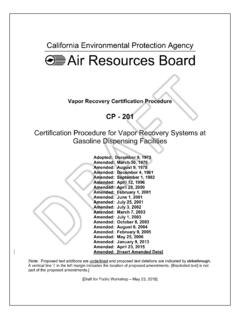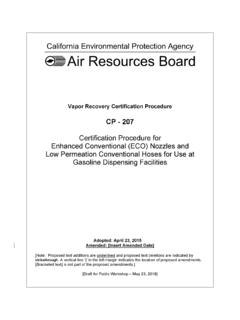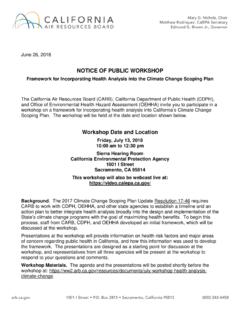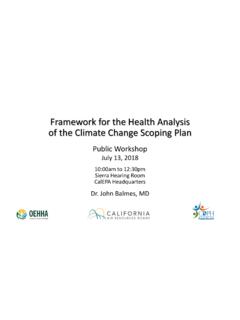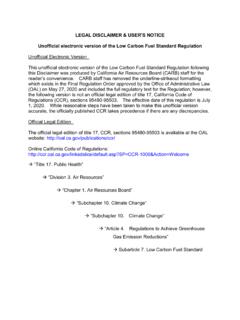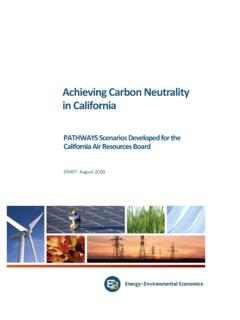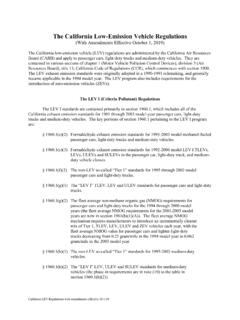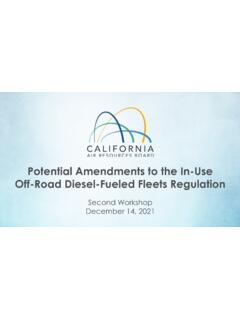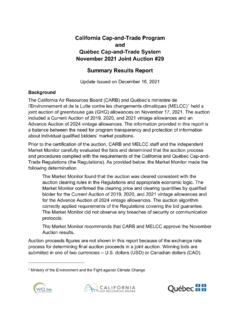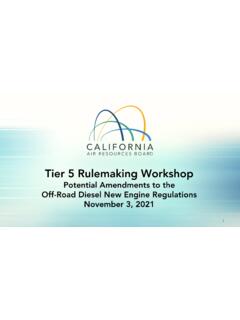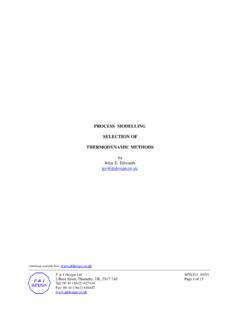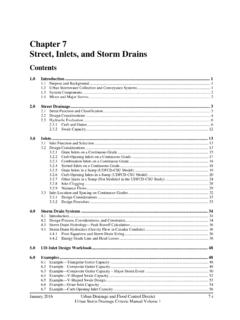Transcription of Title 13, California Code Regulations, Section 1968.2 ...
1 Title 13, California Code Regulations, Section , Malfunction and Diagnostic System Requirements for 2004 and Subsequent Model-Year Passenger Cars, Light-Duty Trucks, and Medium-Duty Vehicles and Engines (OBD II). i Table of Contents (a) 1. (b) APPLICABILITY.. 1. (c) DEFINITIONS.. 1. (d) GENERAL 8. (1) The OBD II 8. (2) MIL and Fault Code Requirements.. 8. (3) Monitoring 12. (4) In-Use Monitor Performance Ratio 14. (5) Standardized tracking and reporting of monitor performance.. 19. (6) Malfunction Criteria Determination for Diesel 21. (7) Enforcement Testing.. 23. (e) MONITORING REQUIREMENTS FOR GASOLINE/SPARK-IGNITED. ENGINES.. 23. (1) CATALYST 23. (2) HEATED CATALYST MONITORING .. 26. (3) MISFIRE MONITORING .. 27. (4) EVAPORATIVE SYSTEM MONITORING .. 33. (5) SECONDARY AIR SYSTEM 36. (6) FUEL SYSTEM 37. (7) EXHAUST GAS SENSOR 40. (8) EXHAUST GAS RECIRCULATION (EGR) SYSTEM MONITORING .. 44. (9) POSITIVE CRANKCASE VENTILATION (PCV) SYSTEM. 44. (10) ENGINE COOLING SYSTEM 45.
2 (11) COLD START EMISSION REDUCTION STRATEGY 49. (12) AIR CONDITIONING (A/C) SYSTEM COMPONENT 51. (13) VARIABLE VALVE TIMING AND/OR CONTROL (VVT) SYSTEM. 51. (14) DIRECT OZONE REDUCTION (DOR) SYSTEM MONITORING .. 52. (15) COMPREHENSIVE COMPONENT MONITORING .. 53. (16) OTHER EMISSION CONTROL OR SOURCE SYSTEM MONITORING. 57. (17) EXCEPTIONS TO MONITORING 58. (f) MONITORING REQUIREMENTS FOR DIESEL/COMPRESSION-IGNITION. ENGINES.. 61. (1) NON-METHANE HYDROCARBON (NMHC) CONVERTING CATALYST. 61. (2) OXIDES OF NITROGREN (NOx) CONVERTING CATALYST. 64. (3) MISFIRE MONITORING .. 67. (4) FUEL SYSTEM 70. (5) EXHAUST GAS SENSOR 73. (6) EXHAUST GAS RECIRCULATION (EGR) SYSTEM MONITORING .. 78. ii (7) BOOST PRESSURE CONTROL SYSTEM MONITORING .. 81. (8) NOx ADSORBER 84. (9) PARTICULATE MATTER (PM) FILTER 86. (10) CRANKCASE VENTILATION (CV) SYSTEM MONITORING .. 88. (11) ENGINE COOLING SYSTEM 90. (12) COLD START EMISSION REDUCTION STRATEGY 93. (13) VARIABLE VALVE TIMING AND/OR CONTROL (VVT) SYSTEM.
3 94. (14) [RESERVED] .. 96. (15) COMPREHENSIVE COMPONENT MONITORING .. 96. (16) OTHER EMISSION CONTROL OR SOURCE SYSTEM MONITORING. 100. (17) EXCEPTIONS TO MONITORING 101. (g) STANDARDIZATION REQUIREMENTS.. 104. (1) Reference Documents:.. 104. (2) Diagnostic Connector: .. 105. (3) Communications to a Scan Tool:.. 105. (4) Required Emission Related Functions: .. 106. (5) In-use Performance Ratio Tracking Requirements: .. 114. (6) Engine Run Time Tracking Requirements: .. 114. (7) Exceptions to Standardization Requirements.. 116. (h) MONITORING SYSTEM DEMONSTRATION REQUIREMENTS FOR. 117. (1) General.. 117. (2) Selection of Test Vehicles: .. 117. (3) Required Testing for Gasoline/Spark-ignited vehicles:.. 117. (4) Required Testing for Diesel/Compression-ignition vehicles: .. 119. (5) Testing Protocol: .. 121. (6) Evaluation Protocol:.. 122. (7) Confirmatory Testing: .. 123. (i) CERTIFICATION DOCUMENTATION.. 124. (j) PRODUCTION VEHICLE EVALUATION. TESTING.
4 127. (1) Verification of Standardized Requirements.. 127. (2) Verification of Monitoring Requirements.. 129. (3) Verification and Reporting of In-use Monitoring 130. (k) DEFICIENCIES.. 131. iii Malfunction and Diagnostic System Requirements--2004 and Subsequent Model-Year Passenger Cars, Light-Duty Trucks, and Medium-Duty Vehicles and Engines (a) PURPOSE. The purpose of this regulation is to establish emission standards and other requirements for onboard diagnostic systems (OBD II systems) that are installed on 2004 and subsequent model-year passenger cars, light-duty trucks, and medium-duty vehicles and engines certified for sale in California . The OBD II. systems, through the use of an onboard computer(s), shall monitor emission systems in-use for the actual life of the vehicle and shall be capable of detecting malfunctions of the monitored emission systems, illuminating a malfunction indicator light (MIL) to notify the vehicle operator of detected malfunctions, and storing fault codes identifying the detected malfunctions.
5 (b) APPLICABILITY. Except as specified elsewhere in this regulation ( Title 13, CCR Section ), all 2004 and subsequent model-year vehicles, defined as passenger cars, light-duty trucks, and medium-duty vehicles, including medium-duty vehicles with engines certified on an engine dynamometer and medium-duty passenger vehicles, shall be equipped with an OBD II system and shall meet all applicable requirements of this regulation ( Title 13, CCR Section ). Except as specified in Section (d)( ), medium-duty vehicles with engines certified on an engine dynamometer may comply with these requirements on an engine model year certification basis rather than a vehicle model year basis. (c) DEFINITIONS. Actual life refers to the entire period that a vehicle is operated on public roads in California up to the time a vehicle is retired from use. Alternate phase-in is a phase-in schedule that achieves equivalent compliance volume by the end of the last year of a scheduled phase-in provided in this regulation.
6 The compliance volume is the number calculated by multiplying the percent of vehicles (based on the manufacturer's projected sales volume of all vehicles) meeting the new requirements per year by the number of years implemented prior to and including the last year of the scheduled phase-in and then summing these yearly results to determine a cumulative total ( , a three year, 30/60/100 percent scheduled phase-in would be calculated as (30*3 years) + (60*2. years) + (100*1 year) = 310). On phase-ins scheduled to begin prior to the 2004. model year, manufacturers are allowed to include vehicles introduced before the first year of the scheduled phase-in ( , in the previous example, 10 percent introduced one year before the scheduled phase-in begins would be calculated as (10*4 years) and added to the cumulative total). However, on phase-ins scheduled to begin in 2004 or subsequent model years, manufacturers are only allowed to include vehicles introduced up to one model year before the first year of the scheduled phase-in.
7 The Executive Officer shall consider acceptable any alternate phase-in that results in an equal or larger cumulative total by the end of the last year of the scheduled phase-in and ensures that all vehicles subject to the phase-in will comply with the respective requirements no later than two model years following the last year of the scheduled phase-in. For alternate phase-in schedules resulting in all vehicles complying one model year following the last year of the scheduled phase-in, the compliance volume shall be calculated as described directly above. For example, a 30/60/100 percent scheduled phase-in during the 2010-2012 model years would have a cumulative total of 310. If the manufacturer's planned alternate phase-in schedule is 40/50/80/100 percent during the 2010-2013 model years, the final compliance volume calculation would be (40*3 years) + (50*2 years) + (80*1. year) = 300, which is less than 310 and therefore would not be acceptable as an alternate phase-in schedule.
8 For alternate phase-in schedules resulting in all vehicles complying two model years following the last year of the scheduled phase-in, the compliance volume calculation shall be calculated as described directly above and shall also include a negative calculation for vehicles not complying until one or two model years following the last year of the scheduled phase-in. The negative calculation shall be calculated by multiplying the percent of vehicles not meeting the new requirements in the final year of the phase-in by negative one and the percent of vehicles not meeting the new requirements in the one year after the final year of the phase-in by negative two. For example, if 10 percent of a manufacturer's vehicles did not comply by the final year of the scheduled phase-in and 5 percent did not comply by the end of the first year after the final year of the scheduled phase-in, the negative calculation result would be (10*(-1 years)) + (5*(-2 years)).
9 = -20. The final compliance volume calculation is the sum of the original compliance volume calculation and the negative calculation . For example, a 30/60/100 percent scheduled phase-in during the 2010-2012 model years would have a cumulative total of 310. If a manufacturer's planned alternate phase-in schedule is 40/70/80/90/100 percent during the 2010-2014 model years, the final compliance volume calculation would be (40*3 years) + (70*2 years) + (80*1. year) + (20*(-1 year)) + (10*(-2 years)) = 300, which is less than 310 and therefore would not be acceptable as an alternate phase-in schedule. Applicable standards refers to the specific exhaust emission standards or family emission limits (FEL) of the Federal Test Procedure (FTP) to which the vehicle or engine is certified. For 2010 and subsequent model year diesel engines, applicable standards shall also refer to the specific exhaust emission standards or family emission limits (FEL) of either the FTP or the Supplemental Emission Test (SET) to which the engine is certified, as determined according to Section (d)(6).
10 Auxiliary Emission Control Device (AECD) refers to any approved AECD (as defined by 40 Code of Federal Regulations (CFR) and ). Emission Increasing Auxiliary Emission Control Device (EI-AECD) refers to any approved AECD that: reduces the effectiveness of the emission control system under conditions which may reasonably be expected to be encountered in normal vehicle operation and use; and the need for the AECD is justified in terms of protecting the vehicle against damage or accident. For medium-duty vehicles certified to an engine dynamometer tailpipe emission standard, an AECD that is certified as an NTE deficiency shall not be considered an EI-AECD. An AECD that does not sense, measure, or calculate any parameter or command or trigger any action, algorithm, or alternate strategy shall not be 2. considered an EI-AECD. An AECD that is activated solely due to operation of the vehicle above 8000 feet in elevation shall not be considered an EI-AECD.
